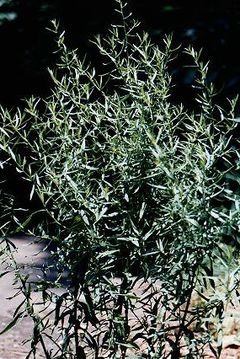Tarragon
2007 Schools Wikipedia Selection. Related subjects: Plants
| iTarragon | ||||||||||||||
|---|---|---|---|---|---|---|---|---|---|---|---|---|---|---|
 |
||||||||||||||
| Scientific classification | ||||||||||||||
|
||||||||||||||
|
|
||||||||||||||
| Artemisia dracunculus L. |
Tarragon (Artemisia dracunculus) is a perennial herb in the family Asteraceae related to wormwood. It is native to a wide area of the Northern Hemisphere from easternmost Europe across central and eastern Asia to western North America, and south to northern India and Mexico. The North American populations may however be naturalised from early human introduction.
Tarragon grows to 20-150 cm tall, with slender, branched stems. The leaves are lanceolate, 2-8 cm long and 2-10 mm broad, glossy green, with an entire margin. The flowers are produced in small capitulae 2-4 mm diameter, each capitulum containing up to 40 yellow or greenish-yellow florets.
Cultivation and uses
Tarragon has a spicy flavour reminiscent of anise. French tarragon is the variety generally considered best for the kitchen, but cannot be grown from seed. Russian tarragon can be grown from seed but is much weaker in flavour.
However, Russian tarragon is a far more hardy and vigorous plant, spreading at the roots and growing over a meter tall. This tarragon actually prefers poor soils and happily tolerates drought and neglect. It is not as strongly aromatic and flavoursome as its French cousin, but it produces many more leaves from early spring onwards that are mild and good in salads and cooked food. The young stems in early spring can be cooked as a tasty asparagus substitute. Grow indoors from seed and plant out in the summer. Spreading plant can be divided easily.
Tarragon is one of the four fines herbes of French cooking, and particularly suitable for fish and chicken dishes.
